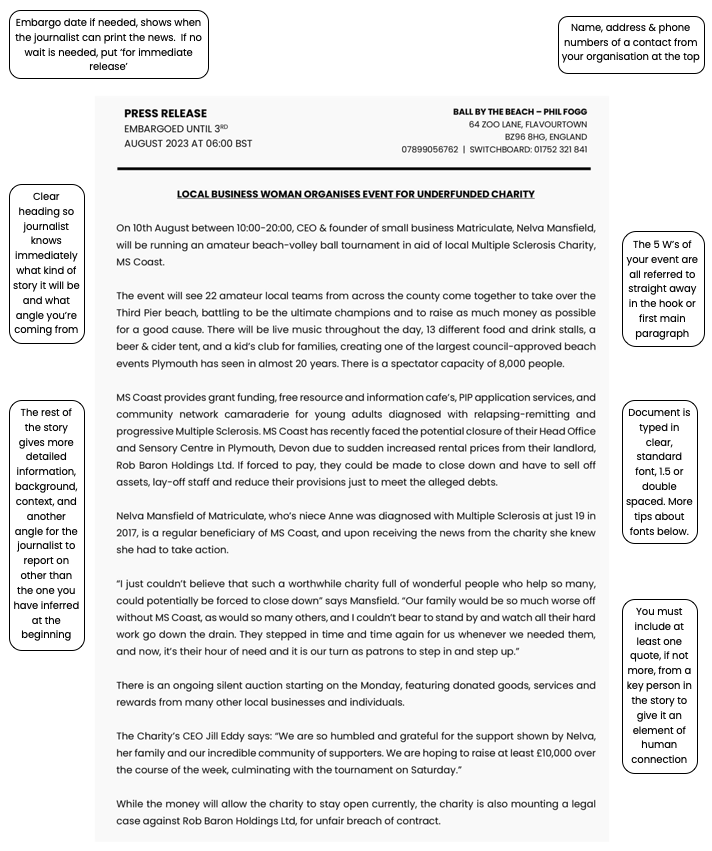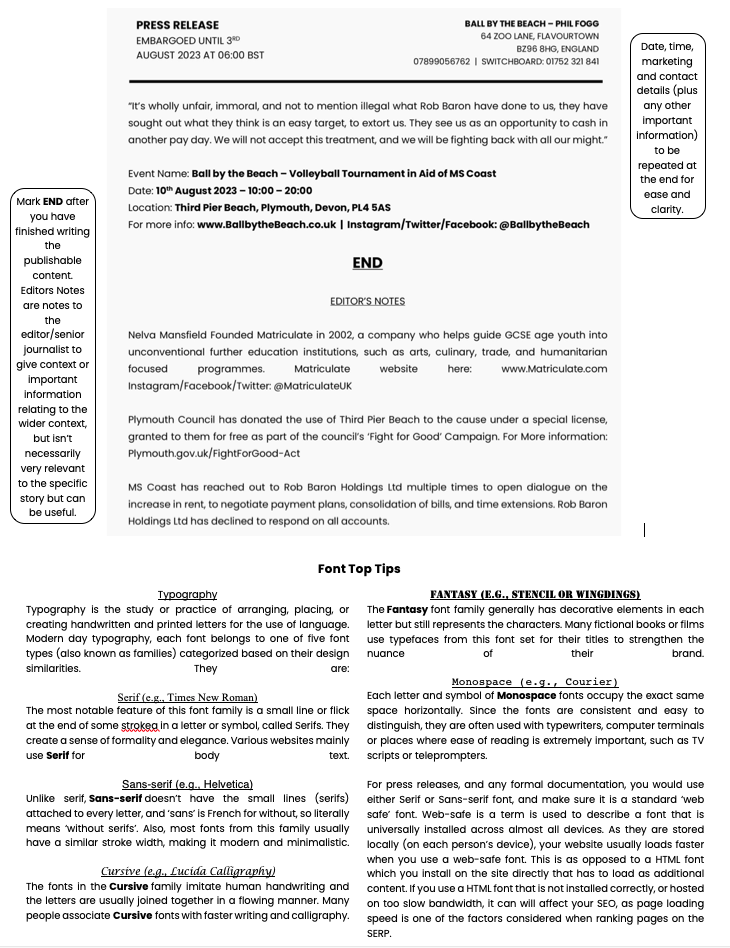3.4b Media & PR Seminar
How to Write Press Releases
Press releases are a time-honoured route to getting your event noticed by local, regional, and national news outlets. It’s not the ONLY way to drum up good PR, but it is one of the most accepted formats around. Journalists and news outlets have been publishing stories based on external press releases for eons, and if you have an engaging news-worthy story, your chances of getting it picked up are very good. There is a very particular structure to modern press releases which should be adhered to at all times if you want the best possible odds of it being run. You must engage at a very specific angle, a lot of events don’t get picked up because their press release simply says ‘an event is happening here’. That in itself is not news worthy, at best they may put in the ‘what’s on’ space of their publication, but no specific coverage. In order to really stand out, you have to think about your event and how it will add value to the reader of that publication:
Do’s:
- Use powerful messaging, there is nothing worse than a boring press release, I promise you it will just get thrown straight into the recycling bin. Enthusiasm, passion and emotive language is key.
- If applicable; act on a report or statistical link previously published
E.g report published stating ‘60% of children don’t know how to code’ = link to your event = event business launches coding camp for U12s this summer - Include any novelty or unusual factors
E.g an event held at a rarely used historical venue. E.g Egyptian relics moved from old museum.
- Community focused feature (this is usually only an angle for not for profit events, but don’t be afraid to hype up this element of community good)
- National or international awareness days, plus macro or micro anniversaries
- International Women’s Day: = link to how the event has a 70% female senior leadership team.
- Business-specific anniversaries or milestones: = New brand launched by business against all odds on 5th year of operating
- Societal or current affairs/news anniversary: = e.g Mick Schumacher signs for first F1 team on 30th anniversary of father Michael Schumacher’s debut F1 season.
- Linking to any wider societal news or phenomenon, anything that is being reported on or in the forefront of people’s consciousness at the time
- An element of first (news is based on what is NEW), even if you think this doesn’t matter, it does matter to journalists! What is new, different or interesting about your event or its message?
- Images and videos are important, whether it goes to print or as online content, the images must be high resolution and a great quality. This could be the deciding factor on whether or not it gets picked up.
Do not’s:
- Only giving basic info, e.g time date location theme of event, make sure there is actual NEWS in the release.
- Litter it with business or industry specific acronyms, general reader won’t understand or care and will tune out
- Use it as a sales pitch, it is indirect advertising and should not scream ‘come to this event please!’ – if ticket prices are relevant to the news angle, they can be included in the editors notes.
- Take this opportunity to include your Company’s/CEO/Founder’s life story or biography, if it’s not a profile piece, the journalist won’t care.
- Make it self-congratulatory. A press release is not a big pat on the back, it is for the journalist to decide how the information you’ve given them will be presented.
Structure:
Don’t always go for the biggest publications possible, local and regional outlets often have a far better reach in specific areas and much prefer local news. More people than you think read local or regional papers when compared with national ones. For example, whilst the readership of the Independent is around 270,000, that of the Manchester Evening News is 547,000 and the Sheffield Star is 246,000. It should also be noted that you are not restricted to traditional print-based newspapers for press releases, you can send releases to local radio, local TV, to niche interest groups, or to online-specific destinations, such as bloggers, e-newsletter writers, or relevant influencers if there is a strong enough link.
It is possible to physically send press-releases into publications via post, this was how releases used to find their way into the hands of journalists. Now days, you would always email them in. An ideal press release covers one to one and half sides of A4 paper equivalent, approximately 600 words on average. You would include the actual release in the body of the email, not as an attachment as it is more likely to get read that way. Any videos or photos can be attached as normal.
Put a contact name at the top and bottom of the press release, together with day/evening/mobile telephone numbers.
Always date your press release, so that a journalist knows how current it is. If a journalist can use the information immediately, then put “For immediate Release” at the top of it. If you do not want the information published before a certain date you can ‘Embargo’ it, this means the information cannot be used or published prior to that date or time. If you wish to embargo a press release, you should put “Embargoed until 0900 hours GMT on (date)” near the top of the release.
Type the heading in capitals and underline it. Don’t write really long sentences or paragraphs. Always spell check and double check for grammatical errors when you have finished.
Make sure that you start with a headline, which is both informative and catchy (but don’t be too clever, or clichéd). Often this is the only part of a press release which a journalist will read – they will use the headline to decide whether to read on.
The first paragraph of a press release should always include the “5 Ws” of the event, so that journalists can get a quick idea of what it’s about without having to read all the way through:
- What is happening?
- Who is doing it?
- Where it is happening?
- When it is happening?
- Why it is happening?
Always include a punchy quote by a company spokesperson, ambassador, even better if it is a celebrity or person of note who endorses the event. This helps to give the story a more personal feel, and you will notice that newspaper articles always try to include a quote from somebody, you can always add a few more quotes if needed.
Remember that the aim of a press release is to get media coverage for your event, so don’t cram it full of detailed or unnecessary information. Always stress the local angle – make it clear to the journalist why your event is something that locals will be interested in. If there is a “photo opportunity” state this at the bottom of the press release, with dates, times and contact numbers.
See below a template of how a press release should normally be laid out:


